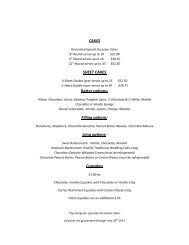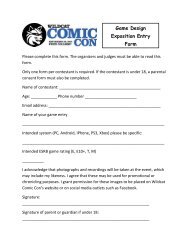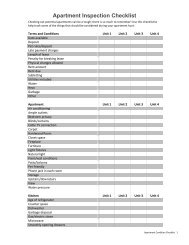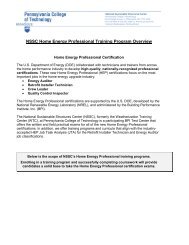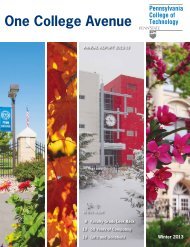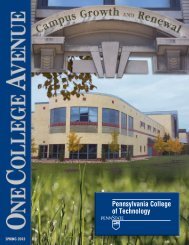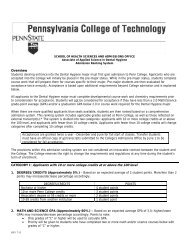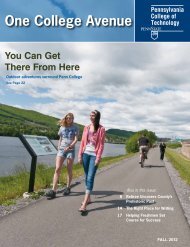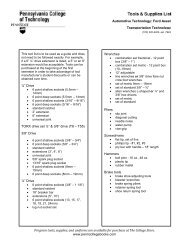Lesson Plan Template - Pennsylvania College of Technology
Lesson Plan Template - Pennsylvania College of Technology
Lesson Plan Template - Pennsylvania College of Technology
Create successful ePaper yourself
Turn your PDF publications into a flip-book with our unique Google optimized e-Paper software.
<strong>Pennsylvania</strong> Governor’s Institute<br />
For Mathematics Educators<br />
2004<br />
Names <strong>of</strong> Group Members: Tommy Bedillion, Donald Deitterick, Debbie<br />
Frank, Stephen Herd, and Anne Marie McDonald<br />
Topic/Theme:<br />
Level:<br />
Time Element:<br />
Geometry Staff Development<br />
3 ½ hours<br />
K through 5 (based on building/district needs)<br />
NCTM Standards Addressed:<br />
Expectations: In grades 3–5 all students should:<br />
• identify, compare, and analyze attributes <strong>of</strong> two-dimensional shapes and develop<br />
vocabulary to describe the attributes;<br />
• classify two-dimensional shapes according to their properties and develop definitions <strong>of</strong><br />
classes <strong>of</strong> shapes such as triangles and pyramids;<br />
• build and draw geometric objects;<br />
PA Math Standards Addressed:<br />
2.9.3. GRADE 3<br />
A. Name and label geometric shapes in two and three dimensions (e.g., circle/sphere,<br />
square/cube, triangle/pyramid, rectangle/prism).<br />
B. Build geometric shapes using concrete objects (e.g., manipulatives).<br />
C. Draw two- and three-dimensional geometric shapes and construct rectangles,<br />
squares and triangles on the geoboard and on graph paper satisfying specific<br />
criteria.<br />
D. Find and describe geometric figures in real life.<br />
I. Predict how shapes can be changed by combining or dividing them.<br />
2.9.5. GRADE 5<br />
A. Give formal definitions <strong>of</strong> geometric figures.<br />
B. Classify and compare triangles and quadrilaterals according to sides or angles.
E. Describe in words how geometric shapes are constructed.<br />
F. Construct two- and three-dimensional shapes and figures using manipulatives,<br />
geoboards and computer s<strong>of</strong>tware.<br />
I. Represent and use the concepts <strong>of</strong> line, point and plane.<br />
J. Define the basic properties <strong>of</strong> squares, pyramids, parallelograms, quadrilaterals,<br />
trapezoids, polygons, rectangles, rhombi, circles, triangles, cubes, prisms, spheres<br />
and cylinders.<br />
L. Identify properties <strong>of</strong> geometric figures (e.g., parallel, perpendicular, similar,<br />
congruent, and symmetrical).<br />
Math Assessment Anchors Addressed:<br />
Grade 3<br />
MC. Geometry<br />
MC.1 Analyze characteristics and properties <strong>of</strong> two- and three- dimensional<br />
geometric shapes and demonstrate understanding <strong>of</strong> geometric relationships.<br />
M3.C.1.1 Identify and/or describe two- and<br />
three-dimensional objects.<br />
Reference: 2.9.3.A<br />
M3.C.1.1.1 Name/identify/describe geometric<br />
shapes in two dimensions (circle,<br />
square, rectangle, triangle,<br />
pentagon, hexagon, and octagon).<br />
M3.C.1.1.2 Name/identify geometric shapes in<br />
three dimensions (sphere, cube,<br />
cylinder, cone, pyramid,<br />
rectangular prism).<br />
M3.C.1.2 Identify/draw right angles and right<br />
triangles.<br />
Reference: 2.10.3.A, 2.10.3.B<br />
M3.C.1.2.1 Identify/draw right angles and right<br />
triangles formed by line segments,<br />
in geometric figures, on a<br />
geoboard, and/or in real-world<br />
objects.<br />
Grade 5<br />
ASSESSMENT ANCHOR<br />
M5.C.1 Analyze characteristics and properties <strong>of</strong> two- and three- dimensional geometric<br />
shapes and demonstrate understanding <strong>of</strong> geometric relationships.<br />
M5.C.1.1 Define and/or use basic properties <strong>of</strong><br />
quadrilaterals (parallelograms,<br />
squares, rectangles, trapezoids,<br />
rhombi), triangles, circles, pyramids,<br />
cubes, and/or prisms.<br />
ELIGIBLE CONTENT<br />
M5.C.1.1.1 Identify/classify/compare cubes,<br />
rectangular prisms and pyramids<br />
using faces, vertices and edges.<br />
M5.C.1.1.2 Identify/classify/compare triangles<br />
and quadrilaterals according to
Reference: 2.9.5.B, 2.9.5.C, 2.9.5.F,<br />
2.10.5.A<br />
M5.C.1.2 Represent and/or use properties <strong>of</strong><br />
lines, line segments, rays, points and<br />
planes.<br />
Reference: 2.9.5.I<br />
sides (length, parallel or<br />
perpendicular) and angles.<br />
M5.C.1.1.3 Identify and/or compare parts <strong>of</strong><br />
right triangles, including right<br />
angles, acute angles, hypotenuse<br />
and legs.<br />
M5.C.1.2.1 Identify, draw and/or label points,<br />
lines, line segments, rays and<br />
planes.<br />
Reading Assessment Anchors Addressed:<br />
ASSESSMENT ANCHOR<br />
R3.A.1 Demonstrate the ability to understand and interpret fiction texts appropriate to<br />
grade level.<br />
ELIGIBLE CONTENT<br />
R3.A.1.1 Identify the meaning <strong>of</strong> vocabulary.<br />
Reference: 1.1.3.E, 1.1.3.F<br />
R3.A.1.1.1 Identify meaning <strong>of</strong> multiplemeaning<br />
words used in text.<br />
R3.A.1.1.2 Identify the meaning <strong>of</strong> an<br />
unfamiliar word if word or picture<br />
clues are available.<br />
R3.A.1.1.3 Identify a synonym or antonym <strong>of</strong><br />
a word or phrase used in the<br />
context <strong>of</strong> the reading passage.<br />
R3.A.2.1 Identify the meaning <strong>of</strong><br />
vocabulary from various subject areas.<br />
Reference: 1.1.3.E, 1.1.3.F<br />
R3.A.2.1.1 Identify the meaning <strong>of</strong> a multiplemeaning<br />
word used in text.<br />
R3.A.2.1.2 Identify the meaning <strong>of</strong> an unfamiliar<br />
word if word or picture clues are<br />
available.<br />
R3.A.2.1.3 Identify a synonym or antonym <strong>of</strong> a<br />
word or phrase used in the reading<br />
passage.<br />
Objectives:<br />
1) To enhance the teachers’ understanding and knowledge <strong>of</strong> analyzing<br />
the characteristics and properties <strong>of</strong> two-dimensional geometric shapes<br />
and demonstrate understanding <strong>of</strong> geometric relationships.<br />
2) To foster and promote the consistent and uniform usage <strong>of</strong> standard<br />
geometric vocabulary and terminology across grade levels.
Instructional Strategies and <strong>Plan</strong> (include strategies used to help<br />
different types <strong>of</strong> learners, i.e. auditory, visual, etc.):<br />
Model differentiated instructional techniques/strategies i.e.:<br />
Visual, Auditory, Kinesthetic, Tactile (VAKT)<br />
Computer assisted instruction<br />
Cooperative grouping<br />
Materials/Resources:<br />
• Geo boards<br />
• two-dimensional geometric manipulatives<br />
• rubber bands<br />
• access to computers with internet hook-up<br />
• LCD projector<br />
• overhead projector<br />
• candy for participants<br />
• AlphaShapes ETA Item # IN034197<br />
Web sites:<br />
Book list:<br />
www.nctm.com<br />
www.cyberchase.com<br />
www.matti.usu.edu/nlvm<br />
www.funbrain.com/brain/mathbrain/mathbrain.html<br />
www.aplusmath.com<br />
www.coolmath4kids.com<br />
www.aaa.math.com/b/geo.htm<br />
www.iit.edu/~smile/mathinde.html<br />
www.shodor.org/interactive/lessons/#geo<br />
www.illuminations.nctm.org<br />
Sir Cumference and the First Round Table by Cindy Neuschwander,<br />
et al<br />
Sir Cumference and the Sword in the Cone by Cindy Neuschwander ,<br />
Wayne Geehan<br />
Sir Cumference and the Great Knight <strong>of</strong> Angleland by Cindy<br />
Neuschwander , Wayne Geehan<br />
Sir Cumference and the Dragon <strong>of</strong> Pi by Cindy Neuschwander , Wayne<br />
Geehan<br />
The Greedy Triangle (Brainy Day Books) by Marilyn Burns, Gordon<br />
Silveria
Three Pigs, One Wolf, and Seven Magic Shapes (Hello Math Reader.<br />
Level 3) by Grace MacCarone, et al<br />
Grandfather Tang’s Story (Dragonfly Books) by Ann Tompert<br />
How Big Is a Foot By Rolf Myller<br />
Interdisciplinary Connections:<br />
• Reading<br />
The teachers will make connections between the selected text,<br />
characteristics, and vocabulary <strong>of</strong> two-dimensional figures.<br />
• <strong>Technology</strong><br />
We will provide pertinent and current interactive websites to<br />
supplement geometry instruction.<br />
Assessment Strategies:<br />
• Formative Evaluation (checking student understanding<br />
during the lesson): Appropriate teacher participation and<br />
feedback pertinent to activities.<br />
• Summative Evaluation (how will it be determined that the<br />
objectives were achieved): Formal and informal teacher<br />
observation and periodic lesson plan evaluation throughout the<br />
school year, ongoing data analysis <strong>of</strong> student performance on<br />
district/standardized assessments, and progress monitoring.<br />
Correctives/Remediation:<br />
• Personal conference<br />
• Peer mentoring/observations<br />
• Ongoing team meetings<br />
• Model lessons<br />
Extensions/Enrichment:<br />
• Further pr<strong>of</strong>essional development<br />
• Specific content study groups<br />
• Development <strong>of</strong> master teachers<br />
• Establish a connection between community and school
Program Agenda:<br />
Concept – Understanding the characteristics and properties <strong>of</strong> twodimensional<br />
figures<br />
Connection - Activity (5 – 10 minutes)<br />
• PSSA type question to assess the teachers’ knowledge base <strong>of</strong><br />
geometry (see Appendix 1)<br />
Reflection <strong>of</strong> activity/discussion (10 – 15 minutes)<br />
Content Instruction – activities (2 hours)<br />
• sort and classify geometric shapes using a Venn diagram* (see<br />
Appendix 3)<br />
• construct specific polygons using two-dimensional geometric shapes*<br />
(see Appendix 4)<br />
• exploration <strong>of</strong> www.illuminations.nctm.org website<br />
*each <strong>of</strong> these activities will include:<br />
• introduction to the activity<br />
• exploration time<br />
• check for understanding during activity<br />
• discussion <strong>of</strong> content<br />
• adaptations/modifications for special needs<br />
Guided Practice: (20 to 30 minutes)<br />
• Read-Aloud <strong>of</strong> The Greedy Triangle (Brainy Day Books) by<br />
Marilyn Burns, Gordon Silveria (see Appendix 2)<br />
Culminating Activity: - (30 Minutes)<br />
• Design an age appropriate activity utilizing the geometric<br />
concepts, including proper vocabulary to be implemented during<br />
their geometry unit.<br />
• Each grade level will share these lessons with the other grade<br />
levels.




